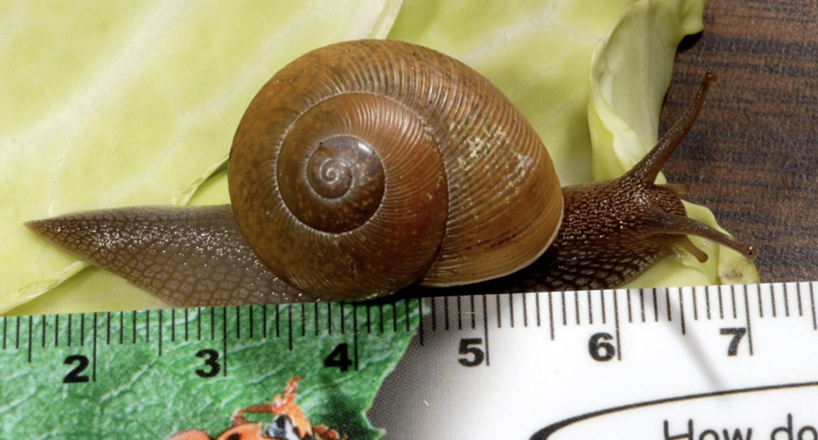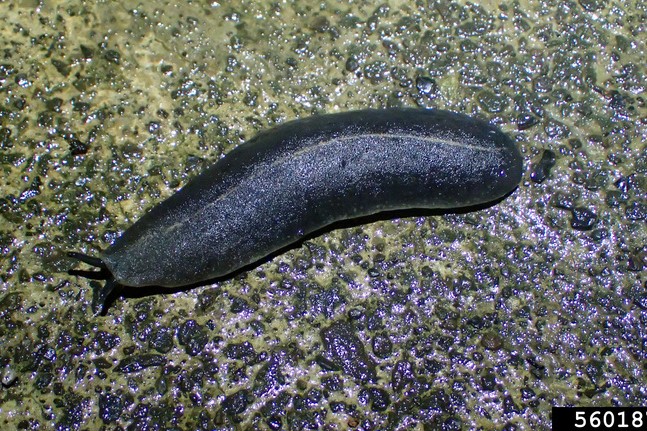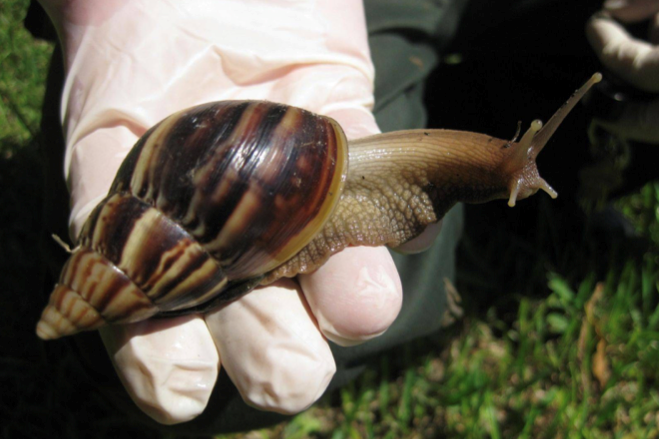Common name: Cuban brown snail
Scientific name: Zachrysia provisoria
Status in Hawaii: Known only from Oahu
Cuban brown snail is a medium-sized terrestrial snail with a heavily ribbed shell, primarily known as a horticultural pest. It readily hitch-hikes in plant material and poses a risk to humans as it carries the parasite that causes rat lungworm.


Impacts
- Nocturnal feeding can damage ornamental plants and garden vegetables.
- This species has considerable potential for spreading to other tropical and subtropical locations. It will burrow into the soil, so it often escapes detection in potted plants.
- Ornamental plants produced in Florida are regularly shipped to other states in the coastal regions of the southern USA and to California, where this species could likely establish. Similarly, its introduction to some Caribbean islands is attributed to horticultural plants shipped from Florida.
- Species of this family have been found to carry several nematode parasites, including Angiostrongylus cantonensis (rat lungworm), A. costaricensis, and A. malaysiensis. Angiostrongylus cantonensis can cause symptoms similar to meningitis in humans including headache, stiff neck, tingling or painful feelings in the skin, low grade fever, nausea, and vomiting.
- It is also an intermediate host to the larval stages of some nematode parasites of vertebrates (dog, cat, and rat lungworms).

Identification
- Medium-sized snail, typically measuring 25 to 30 mm (roughly 1in) in diameter at maturity.
- The shell consists of 4-5 rapidly expanding whorls. It lacks an umbilicus (a hollow cone-shaped space found within the whorls of a coiled mollusk shell, visible from below).
- Regular, strong, curved ribs are found on the upper surface of the shell, though the lower surface is less well sculptured. The margin (lip) of the aperture (opening) and columella is typically white, in sharp contrast with the brown (yellowish-brown to dark brown) shell.


Vectors/Commodities
- Z. provisoria is known mostly as a pest of ornamental crops, affecting plants such as bougainvillea, crepe myrtle, hibiscus, ti plant, impatiens, orchids, bromeliads, ornamental asparagus, begonia, ornamental cactus, aroids (Araceae) and cut flowers.
- Also affected are citrus crops, brassica crops, peppers, sweet potato, starfruit, mango, and others. Z. provisoria climbs trees readily and can damage tree foliage and remove bark from stem tissue.

Distribution
- This species is native to Cuba and probably reached the Bahamas late in the 19th century. It has since been detected on a variety of Caribbean islands. It has also been detected in shipments from Guatemala, Costa Rica, Haiti, and the Dominican Republic, where it is not known to be established.
- In the US, this pest has become widespread in Florida and California.

Best Management Practices
- This species is not widespread throughout the state. Prevention and early detection are key to containment and eradication efforts that protect the nursery industry and community from further impacts.
- Consider sourcing options and pest distribution when purchasing plants.
- BOLO: Be on the lookout! Carefully inspect all shipments of commodities from the distribution range for slugs and feeding damage. Routine nursery surveys are a proactive way to detect the presence of new pests.
- Search in heavily vegetated areas near where feeding damage has been observed, under debris, rocks, pots, and other areas where slugs/snails seek refuge.
- Trapping cannot be used alone but can be used to supplement visual surveying. Traps are not species-specific and will attract non-target species, including non-mollusks. Trap placement can occur in the same areas where visual surveys occur.
- Manage slug and snail populations by limiting the number of places slugs and snails can hide in. Remove unnecessary groundcover, cut back vegetation, and remove unnecessary items stored in contact with the ground.
- Report any suspect pests to 643pest.org or by phone 643-PEST (7378).

References
- HDOA
- Best On-Farm Food Safety Practices: Reducing Risks Associated with Rat Lungworm Infection and Human Eosinophilic Meningitis
- CTAHR Rat Lungworm Management
- iNaturalist
- USDA Animal and Plant Health Inspection Service
- Invasive Species Compendium
- University of Florida
- UH College of Tropical Horticulture and Human Resources
Other Nursery Pests
PEST PREVENTION TRAINING
An advanced education program for those on the front lines protecting Hawaii from invasive species.
Contact your local Invasive Species Committee to schedule a training for your team. Learn more
This material was made possible, in part, by a Cooperative Agreement from the United States Department of Agriculture’s Animal and Plant Health Inspection Service (APHIS). It may not necessarily express APHIS’ views.































